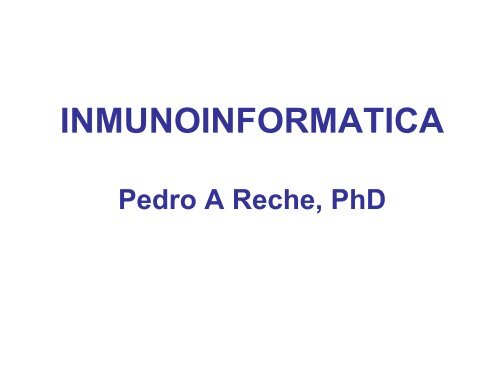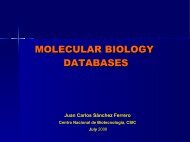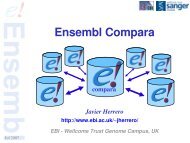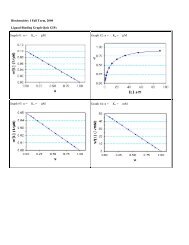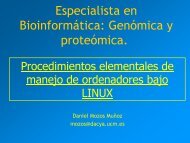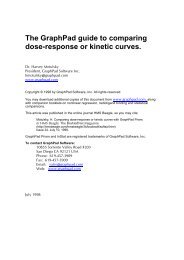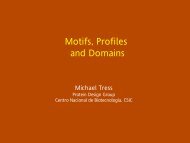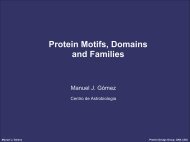INMUNOINFORMATICA - CNB - Protein Design Group
INMUNOINFORMATICA - CNB - Protein Design Group
INMUNOINFORMATICA - CNB - Protein Design Group
Create successful ePaper yourself
Turn your PDF publications into a flip-book with our unique Google optimized e-Paper software.
<strong>INMUNOINFORMATICA</strong><br />
Pedro A Reche, PhD
INDEX<br />
• IMMUNE SYSTEM<br />
• AREAS OF RESEARCH IN<br />
IMMUNOINFORMATICS<br />
• COMPUTATIONAL VACCINOLOGY
<strong>INMUNOINFORMATICA</strong>?<br />
• IMMUNOINFORMATICS: Study of the immune<br />
system through the use of computers<br />
– Existencia masiva de Datos concernientes al sistema<br />
inmune<br />
– Problemas especificos relacionados con el sistema<br />
inmune<br />
– Complejidad del sistema
IMMUNE SYSTEM FUNCTION: SELF VS NON<br />
SELF RECOGNITION<br />
The immune system offer protection against infections<br />
• Immune system function is based on discriminating between self and non-self<br />
• Self and non-self discrimination is achieved through the recognition of small molecular<br />
subunits (antigens): self and non-self antigens<br />
• Self antigens confer tolerance and non-self (foreign) antigens activate the immune system<br />
Self Antigens<br />
Foreign Antigens
IMMUNE SYSTEM ORGANS<br />
Functions:<br />
• Production of Immune<br />
system cells<br />
• Maturacion and education<br />
of Immune system cells<br />
• Immune system recognition<br />
and activation
IMMUNE SYSTEM CELLS:<br />
HEMATOPOYESIS<br />
Innate Immune System<br />
Adaptive immune system<br />
Innate Immune System
Innate versus Adaptive Immune<br />
System<br />
Nonspecific<br />
Specific<br />
Humoral<br />
Cellular<br />
Humoral<br />
Cellular<br />
complement,<br />
interferon,<br />
TNF etc.<br />
macrophages,<br />
neutrophils,<br />
NK cells<br />
Antibodies<br />
(B cells)<br />
T cells
ANTIGEN SPECIFIC<br />
RECEPTORS<br />
BCR<br />
TCR<br />
10 20<br />
10 8
DIVERSITY OF TCR AND BCR REPETOIRES IS GENERATED<br />
BY SOMATIC RECOMBINATION<br />
( S. Tonegawa)<br />
V (250) D (15) J (4)<br />
//<br />
//<br />
Germline DNA<br />
DJ rearrangement<br />
// Lymphocyte Precursor DNA<br />
VDJ rearrangement<br />
Lymphocyte DNA
B-CELL ACTIVATION: SELECTION<br />
No<br />
Affinity<br />
AND CLONAL EXPASION<br />
Low<br />
Affinity<br />
No<br />
Affinity<br />
Somatic<br />
Hypermutations<br />
High Affinity<br />
Memory B-<br />
cells<br />
Plasma<br />
cells
ANTIBODY - ANTIGEN<br />
INTERACTION<br />
Antigen<br />
Fab<br />
Fab<br />
Epitope<br />
Paratop<br />
e<br />
Fc<br />
Antibod<br />
y
ANTIGEN RECOGNITION BY T<br />
CELLS<br />
1 : T cells recognize peptides (about 9 amino acids)<br />
and not native antigen<br />
2 : T cells recognize peptides when bound to<br />
their own MHC<br />
CD4 T cells : MHC-cl II<br />
CD8 T cells : MHC-cl I
Structural recognition of peptide-MHCI by TCR<br />
CD8+ T-CELL<br />
CD4 T-CELL<br />
TCR<br />
TCR<br />
CD4<br />
pMHCI<br />
CD8<br />
pMHC<br />
β2m<br />
APC<br />
APC<br />
CD8 T-cell<br />
CD4 T-cell<br />
TCR<br />
CD8<br />
TCR<br />
CD4<br />
MHCI<br />
APC<br />
MHCII<br />
APC
Structural features of TCR Recognition of pMHCI<br />
complexes<br />
K<br />
Y<br />
F<br />
TCR<br />
A T<br />
Gp3341<br />
D b<br />
Gp3341<br />
1 4 6 7 8<br />
K A V Y N F A T C<br />
TCR CONTACTS
TCR-PMHC FIT AND SELF TOLERANCE OF T-CELLS IS<br />
ADQUIRED DURING THYMIC SELECTION<br />
Thymocyte selection is mediated by<br />
peptide/MHC/TCR interactions<br />
1. 2. 3.<br />
APC<br />
APC<br />
APC<br />
MHC<br />
Ø<br />
+++<br />
+<br />
Interact.<br />
TCR<br />
T<br />
T<br />
T<br />
Nature Reviews Immunology 4; 278-289 (2004);<br />
Death<br />
Neglect<br />
Death<br />
– selection<br />
Survival<br />
+ selection
In humans, MHC molecules are extremely<br />
polymorphic<br />
HLA<br />
Chr6<br />
DP DQ DR<br />
B C<br />
A<br />
HLA II<br />
HLA I<br />
HLA MOLECULE SEQUENCES<br />
HLAA*0101<br />
CLASS I<br />
HLA-A 230<br />
Black<br />
Caucas.<br />
Hispan.<br />
Nat.Ame<br />
Asian<br />
HLA-B 447<br />
HLA-C 97<br />
CLASS II<br />
HLA-DPA 12<br />
GF<br />
PF<br />
5.6%<br />
10.8%<br />
15.1%<br />
27.9%<br />
6.0%<br />
11.6%<br />
7.5%<br />
14.4%<br />
1.5%<br />
3.0%<br />
HLA-DPB 90<br />
HLA-DQA 17<br />
HLAB*4402<br />
HLA-DQB 42<br />
HLA-DRA 2<br />
HLA-DRB1 271<br />
HLA-DRB3 30<br />
HLA-DRB4 7<br />
GF<br />
PF<br />
Black<br />
2.0%<br />
3.9 %<br />
Caucas.<br />
11.75%<br />
22.0 %<br />
Hispan.<br />
6.7%<br />
12.39%<br />
Nat.Ame<br />
3.4%<br />
8.3 %<br />
Asian<br />
0.7%<br />
1.3 %<br />
HLA-DRB5 14
INNATE AND ADAPTIVE<br />
IMMUNE SYSTEM<br />
ANTIGEN PROCESSING AND PRESENTATION<br />
INNATE<br />
ADAPTIVE
CELLS OF THE INNATE IMMUNE<br />
SYSTEM WORK AS ANTIGEN<br />
PRESENTIG CELLS<br />
Phagocytic cells:<br />
Granulocytes<br />
Monocytes<br />
Macrophages<br />
Dendritic cells
IMMUNE RESPONSE<br />
Lymph node<br />
Skin/Mucosal surface<br />
pathogen<br />
memory<br />
APC(DC)<br />
migration<br />
CD8 CD8<br />
migration<br />
CD8<br />
cytotoxic T-cells<br />
CD4<br />
CD4<br />
CD4<br />
cellular immunity<br />
CD8<br />
CD8<br />
CD8<br />
CD4<br />
CD4<br />
migration<br />
CD8<br />
CD4<br />
DC<br />
CD8<br />
B<br />
B<br />
CD4<br />
B<br />
B<br />
CD4<br />
B<br />
B<br />
CD4<br />
isotypic switch<br />
and affinity<br />
maturation<br />
IgM<br />
IgG<br />
IgA<br />
Bonne marrow<br />
AFC<br />
B<br />
B<br />
migration<br />
B<br />
memory<br />
IgE<br />
Humoral response
CD8 T cell Efector Function
CD4 T cell Efector Function:<br />
B-Cell Activation<br />
TCR<br />
T Helper Cell<br />
B Cell<br />
Class II MHC<br />
Bound Peptide<br />
Ab (Antibodies)
B cells – memory cells
IMMUNOINFORMATICS: AREAS OF<br />
DEVELOPEMENT<br />
• Specialized Databases and Resources<br />
• System level models describing immune system<br />
proceses<br />
• Molecular models describing immune system<br />
features: Antigen recognition
IMMUNOINFORMATICS: AREAS OF<br />
DEVELOPEMENT<br />
• Generation of Specialized Databases and Resources<br />
• Databases of immunological sequences: IMGT<br />
• Databases of epitopes: EPIMHC<br />
• Database of pathogens: HIV database
IMMUNOINFORMATICS<br />
DATABASES: IMGT<br />
http://imgt.cines.fr/
IMMUNOINFORMATICS DATABASES:<br />
EPIMHC<br />
http://bio.dfci.harvard.edu/epimhc/
IMMUNOINFORMATICS:<br />
SYSTEM LEVEL MODELS<br />
• Symbolic models describing processes at cellular and organ<br />
levels:<br />
- Immune response to viruses. Dahari H, Lo A, Ribeiro RM, Perelson AS.,<br />
Modeling hepatitis C virus dynamics: liver regeneration and critical drug<br />
efficacy.J Theor Biol. 2007 Jul 21;247(2):371-81.<br />
- Analysis of MHC diversity under host-pathogen coevolution.<br />
Bhattacharya T, et al effects in the assessment of HIV polymorphisms and<br />
HLA allele associations.Science. 2007 Mar 16;315(5818):1583-6.<br />
- B cell maturation. Meyer-Hermann et al. An analysis of B cell selection<br />
mechanisms in germinal centers. Math Med Biol. 2006 Sep;23(3):255-77<br />
- Dynamic models that simulate both cellular and humoral immune<br />
responses. Pappalardo et al simulation of cancer<br />
immunoprevention vaccine.Bioinformatics. 2005 Jun<br />
15;21(12):2891-7.
IMMUNOINFORMATICS:<br />
MOLECULAR MODELS<br />
• Use molecular data (sequences, 3D etc)<br />
• B cell epitope prediction<br />
• Modeling of antigen processing events<br />
• T cell epitope prediction<br />
• Computer aided design of vaccines: Formulation of<br />
vaccines
WHY BOTHER EPITOPE<br />
PREDICTION?<br />
• Predicting the target of the immune system<br />
is of practical relevance for:<br />
– Understanding disease pathogenesis and for<br />
making vaccines<br />
– Understanding the processes selection<br />
tolerance, memory and aging of the immune<br />
system
Prediction of T cell epitopes<br />
➩ T cell epitopes are peptides derived from the processing of proteins that<br />
are able to activate T cells in a detectable manner<br />
APC<br />
Mechanisms that needs to be modeled<br />
• Antigen processing. Whether a peptide is<br />
processed (released) from a protein in vivo<br />
• Binding of the peptide to the MHC<br />
molecule<br />
• Recognition of the peptide-MHC by the<br />
TCR with enough affinity.<br />
MHC<br />
P<br />
P<br />
TCR<br />
T CELL<br />
MHC-p-TCR
2<br />
1.8<br />
1.6<br />
1.4<br />
1.2<br />
1<br />
0.8<br />
0.6<br />
0.4<br />
0.2<br />
0<br />
Qui ckTi me and a TI FF (Unc omp ress ed) dec omp ress or are n eeded to se e thi s pi cture .<br />
I G I W G C S G K L I C T T N V P W N S S W S N K S Q S E I W D N M<br />
Antigen Processing<br />
Computer tools for epitope discovery<br />
peptide-MHC binding<br />
P5 P4 P3 P2 P1 P1' P2' P3' P4 '<br />
P5'<br />
APC<br />
P<br />
MHC<br />
TCR<br />
T CELL<br />
TCR recognition/Immunodominance<br />
Variability parsing<br />
Shannon filter<br />
G I W G C S G K L I C T T . V P W N S S W S N K S . . E I W . N M
RANKPEP:SERVIDOR PARA LA PREDICCION<br />
DE EPITOPOS<br />
http://bio.dfci.harvard.edu/Tools/rankpep.html<br />
• RANKPEP es la herramienta mas frecuentemente<br />
usada para al predicción de epitopos T (google y<br />
400,000 hits)<br />
• Posibilita la predicción de epitopos restringidos por<br />
moléculas MHCI y MHCII<br />
• Proporciona la colección mas amplia de moléculas<br />
de MHC<br />
• Predicción del corte por el proteosoma<br />
• Es posible predecir cuales son los epitopos<br />
inmunodominantes<br />
• Flexibilidad y versatilidad:<br />
• INPUT: Proteína/s o alineamientos de<br />
proteínas.<br />
• Posibilidad de limitar los resultados de<br />
acuerdo a su peso molecular<br />
• Posibilidad de identificar epítopos<br />
conservados
GENERAL PROCEDURE TO DERIVE<br />
DATA DRIVEN MODELS<br />
1. Data Collection. Eg. Sequences of T cell<br />
epitopes<br />
– Databases Search<br />
– Text mining<br />
• Training. Machine Learning Algorithms<br />
• Testing and Evaluation.
GENERATION OF MLA-BASED<br />
PREDICTICE MODELS<br />
D +<br />
DATABASE<br />
Annotated sequences<br />
+ Sequence IS a T cell epitope<br />
D – – Sequence is NOT T cell epitope<br />
Codificacion de datos en vectores numericos de longitud fija<br />
+<br />
D t<br />
–<br />
D t<br />
(Hidrofilicidad, Accesibilidad, 1)<br />
(Hidrofilicidad, Accesibilidad, 0)<br />
MLA<br />
PREDICTIVE MODEL
MLA: WEKA<br />
• Support Vector Machine<br />
• Decision Trees<br />
• Artificial Neural Networks<br />
• K-nearest neighbour learner
EVALUATION<br />
• Select a parameter to quantify the<br />
perfomance of model (accuracy, MCC, etc)<br />
• Evaluate performace through x-validation.<br />
– Train on a subset of the data and test in the<br />
remaining dataset
Computer aided design of epitope<br />
based vaccines: Computational<br />
Vaccinology
MOTIVACION/OBJETIVO<br />
DESARROLLO DE UNA VACUNA DE<br />
EPITOPOS T CD8 FRENTE A HIV-1<br />
Pedro A. Reche § , et al (2006) Elicitation form virus-naive individuals of cytotoxic T lymphocytes directed<br />
against conserved HIV-1 epitopes. Medical Immunology, 5:1
KNOWN CTL EPITOPES IN HIV-1<br />
INFECTED HUMANS<br />
Los Alamos HIV database is depositary of Tcell epitopes from HIV and SIV<br />
http://hivweb.lanl.gov/content/index<br />
• CTL epitope example record<br />
Displaying record number 1<br />
HXB2 Location p17(1826)<br />
Author Location p17(1826 IIIB)<br />
Sequence KIRLRPGGK<br />
Species(HLA) human (A3)<br />
Immunogen HIV1 infection<br />
Keywords<br />
Notes<br />
References<br />
• 1567 CTL epitope records => 592 unique seq =>195 9mers<br />
Immunogen HIV1 infection<br />
Species(HLA) human<br />
• CTL epitopes from HIV infected patients infected could be used as the basis of a<br />
vaccine against HIV1. How?
Criteria for a CTL epitope vaccine<br />
against HIV-1<br />
1. It should be protective against any of HIV-1 variants<br />
• Selected HIV-1 specific CTL epitopes must be<br />
conserved among all HIV-1 variants<br />
2. It should protect the whole population.<br />
• Selected HIV-1 specific CTL epitopes should be of<br />
promiscuous HLA I binding so that they can elicit T<br />
cell response in people with different genetic<br />
backgrounds
HIV-1 SEQUENCES
2<br />
1.8<br />
1.6<br />
1.4<br />
1.2<br />
1<br />
0.8<br />
0.6<br />
0.4<br />
0.2<br />
0<br />
QuickTime and a TIFF (Uncompress ed) decompress or are needed to s ee this picture.<br />
HIV1<br />
Selection of Conserved CTL<br />
GAG<br />
POL<br />
ENV<br />
VIF<br />
TAT<br />
REV<br />
VPU/VPX<br />
VPR<br />
NEF<br />
Clustalw<br />
GAG.aln<br />
POL.aln<br />
ENV.aln<br />
VIF.aln<br />
TAT.aln<br />
REV.aln<br />
VPU.aln<br />
VPR.aln<br />
NEF.aln<br />
Mask variability<br />
GAG.seq<br />
POL.seq<br />
ENV.seq<br />
VIF.sea<br />
TAT.seq<br />
REV.seq<br />
VPU.seq<br />
VPR.seq<br />
NEF.seq<br />
G I W G C S G K L I C T T N V P W N S S W S N K S Q S E I W D N M<br />
H=1<br />
Shannon filter<br />
G I W G C S G K L I C T T . V P W N S S W S N K S . . E I W . N M<br />
Only HIV-1 specific CTL epitopes that match the consensus sequences<br />
are considered for further analysis
Conserved HIV1 CTL Epitopes<br />
H < 1<br />
HIV CTL SOURCE POS ALLELES (HIVDB)<br />
SPRTLNAWV: p24 1624 B0702<br />
AVFIHNFKR: Integrase 179187 A0301<br />
MAVFIHNFK: Integrase 178186 A0301<br />
TLFCASDAK: gp160 5159 A0301<br />
FPVRPQVPL: Nef 6876 B3501<br />
RAMASDFNL: Integrase 2028 A0201<br />
KLTPLCVTL: gp160 121129 A0201<br />
TLNAWVKVI: p24 1927 A0201<br />
VIYQYMDDL: RT 179187 A0201<br />
LVGPTPVNI: Protease 7684 A0201<br />
TVLDVGDAY: RT 107115 B3501<br />
PLVKLWYQL: RT 421429 A0201<br />
TLNFPISPI: POL POL A0201<br />
NTPVFAIKK: RT 5765 A0301<br />
SEGATPQDL: p24 4452<br />
EKEGKISKI: RT 4250 B5101<br />
LLWKGEGAV: Integrase 241249 A0201<br />
KLVGKLNWA: RT 259267 A0201<br />
LTFGWCFKL: Nef 137145 A0201<br />
YQYMDDLYV: RT 181189 A0201<br />
GPKVKQWPL: RT 1826 B0801<br />
WASRELERF: p17 3644 B3501<br />
RAIEAQQHL: gp160 557565 B5101 B1501 C0304<br />
GLNKIVRMY: p24 137145 B1501<br />
KEKGGLEGL: Nef 92100 B4002<br />
YFPDWQNYT: Nef 120128 A1 B3701 B5701<br />
WYIKIFIMI: gp160 680688 A2402<br />
YVDRFFKTL: p24 164172 A2601<br />
FVNTPPLVK: RT 416424 A1101<br />
DRFFKTLRA: p24 166174 B1402<br />
KIQNFRVYY: Integrase 219227 A3002<br />
KLNWASQIY: RT 263271 A3002<br />
QGWKGSPAI: RT 151159 B5101<br />
IRLRPGGKK: p17 1927 B2705<br />
DLSHFLKEK: Nef 8694 A0301<br />
KIRLRPGGK: p17 1826 A0301 B0301<br />
GIPHPAGLK: RT 93101 A0301<br />
MTKILEPFR: RT 164172 A0301<br />
AETFYVDGA: RT 437445 B4501<br />
EEKAFSPEV: p24 2836 B4415<br />
CRAPRKKGC: p2p7p1p6 4250 B1402<br />
ITLWQRPLV: Protease 0311<br />
Total: 42 peptides<br />
Conser.<br />
H < 0.5<br />
CTL SOURCE POS ALLELES (HIVDB)<br />
SPRTLNAWV p24 1624 B0702 B7<br />
AVFIHNFKR Integrase 179187 A0301<br />
MAVFIHNFK Integrase 178186 A0301<br />
LVGPTPVNI Protease 7684 A0201 A2<br />
TVLDVGDAY RT 107115 B3501 B35<br />
GLNKIVRMY p24 137145 B1501<br />
SEGATPQDL p24 4452 B60<br />
PLVKLWYQL RT 421429 A0201<br />
LLWKGEGAV Integrase 241249 A0201<br />
FVNTPPLVK RT 416424 A1101<br />
KLVGKLNWA RT 259267 A0201<br />
YQYMDDLYV RT 181189 A0201<br />
QGWKGSPAI RT 151159 B5101 B62<br />
GIPHPAGLK RT 93101 A0301<br />
LTFGWCFKL Nef 137145 A0201<br />
TLNFPISPI POL<br />
A2<br />
KLNWASQIY RT 263271 A3002 A30<br />
Total: 17 peptides<br />
Experimental HLAI binding from<br />
HIV database
Extended HLAI binding Profile of HIV1<br />
specific CTL Epitopes<br />
Apply an algorithm to identify combinations of epitopes providing a population<br />
coverage of 95%<br />
A minimum of 5 peptides are required to cover the whole population
Responses of stimulated T cells from naïve<br />
people to CTL pools<br />
B)<br />
HIV naive<br />
Dentritic APC + pepides pools<br />
PBMC<br />
Peptide pools<br />
10µM<br />
T Cells ->(2.5 x 10 5 /well)<br />
PBMC -> 2.5 x 10 5 /well)<br />
Anti-IFγ coated plate<br />
Elispot reader<br />
(SPC)
Characterization of HLA-A0201 restricted HIV-1 peptidespecific<br />
T cell lines from uninfected individuals
Cytotoxic activity of HIV-1 peptide-specific A0201-<br />
restricted T cells from naive donors<br />
T2 cells + peptide +<br />
A0201-restricted HIV-1 specific T cell<br />
T1 cells infected/uninfected with HIV-<br />
IIIB
Conclusions<br />
• Naïve individual have the potential to recognize invariant HIV-1 specific T cell<br />
epitopes<br />
• Chronic infections and diseases such as cancer may result in the<br />
impairment of T cell immune response and therefore epitope vaccine<br />
optimization should be carried out from data obtained in naïve healthy patients<br />
• Chronic infections and diseases escape the immune system due the<br />
emergence of escape mutants that are no longer the target of the immune<br />
system and/or by directing the immune response towards antigenic<br />
determinants that results in futile pattern of immunodominance. These two<br />
issues can be better addressed using epitope-based vaccines that allow to<br />
focus the immune response towards the desired regions (strictly conserved<br />
epitopes)
Innate responses to virus<br />
infection
BIOINFORMATICA<br />
• La Bioinformática podría definirse como el campo de la ciencia en el que las Matemáticas, las<br />
Ciencias Computacionales y de la Información se encuentran con la Biología para crear un una<br />
disciplina nueva.<br />
DATOS Y INFORMACION/HIPOTESIS<br />
Matemat.<br />
Cienc. Comp.<br />
C. Información Biología<br />
Bioinformática/<br />
Biologia Computac.<br />
Bases de Datos, herramientas de gerencia<br />
Modelos Computacionales para el análisis e interpretacion de datos<br />
Conocimiento Biologico


